
Introduction of Beam Bridge
Bridges are one of the most important parts of the Infrastructure of the country which plays a great role in the transportation of raw materials from one end to another end.
There are many types of bridges which are constructed for the movement of traffic. In which article, you will get to know about beam Bridge and the types of beam Bridge.
What Is Beam Bridge?

A beam bridge is one of the most common and widely used basic types of Bridge, also known as the Girder Bridge. This article provides a comprehensive beam bridge definition and insights into its various aspects.
The main aim of constructing a bridge is to provide passage of traffic from one end to another end. Beam Bridges are the simplest structural forms for the spans of the bridge which is supported by the abutments or piers at each end.
It is basically a horizontal slab for beam which is supported at each end. Beam Bridge is a common type of bridge which is held by the supports at the ends.
In this type of bridge, no moments will get transferred throughout the support so that it is known as simply supported. Beam bridges can carry pedestrians, trucks, light rail and heavy rail etc.
It is very necessary to calculate all the bending moments in a beam to establish a safe design for the construction of beam bridges.
Material Used in the Construction of Beam Bridge.
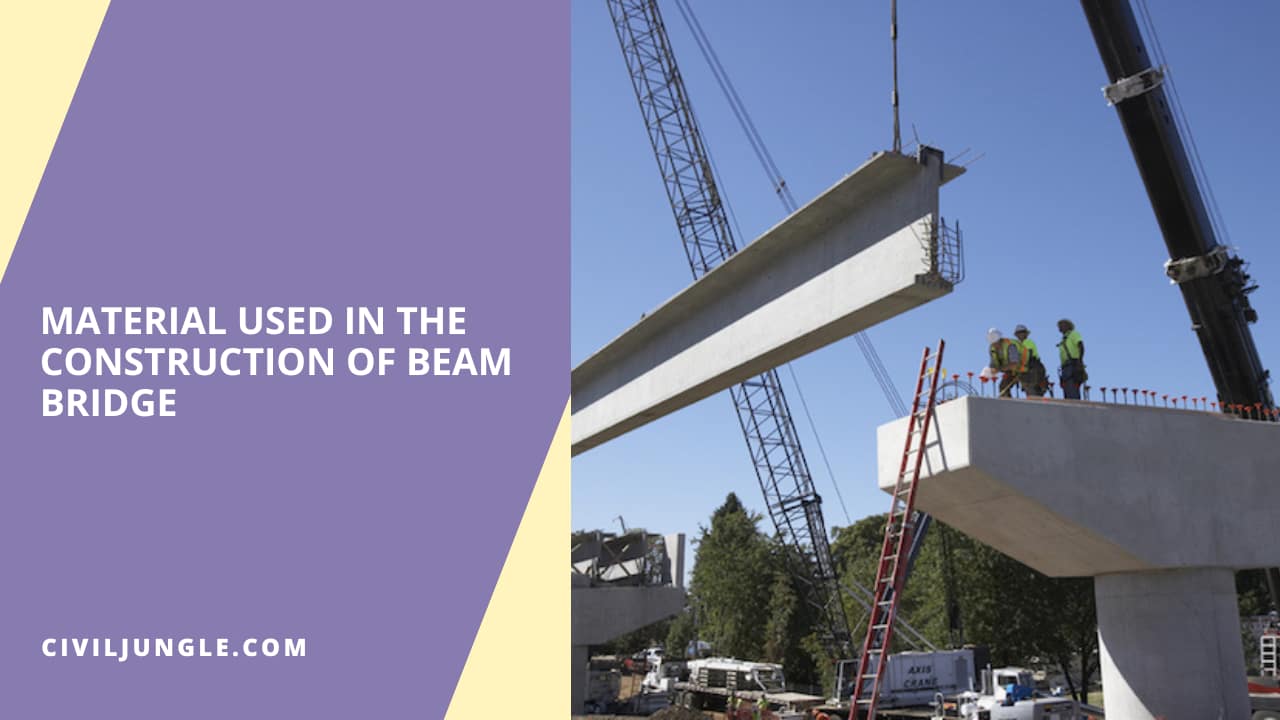
Nowadays, with advancements in technology, various materials are used for the construction of bridges, especially in the context of a beam and column bridge. The materials which are used in the construction of beam bridges are as follows.
- Timber
- Iron
- Steel
- Reinforced cement concrete
- Prestressed concrete.
Prestressed concrete material is best for the construction of beam Bridge because it can endure high compressive stresses.
Types of Beam Bridges
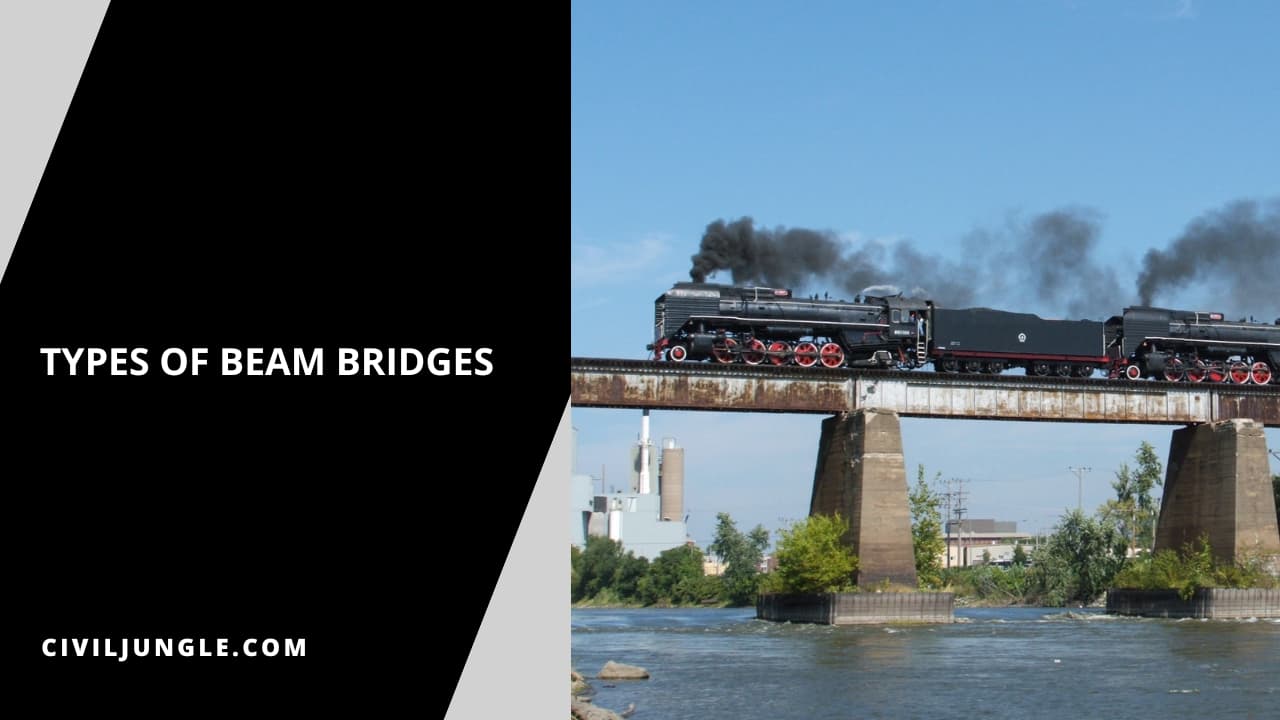
The Beam Bridge is categorised into mainly four types which are listed below.
#1 Based on the Geometry
- Straight beam Bridge
- Curved beam Bridge
- Tapered beam Bridge
#2 Based on the Shape of the Cross-Section of the Bridge
- I-Beam Bridge
- T-Beam Bridge
- C-Beam Bridge
#3 Based on the Equilibrium Conditions of the Bridge
- Statically determinate beam Bridge
- Statically indeterminate beam Bridge
#4 Based on the Type of Support
- Simply supported beam Bridge
- Cantilever beam Bridge
- Overhanging beam Bridge
- Continuous beam Bridge
- Fixed beam Bridge
Description of the beam Bridges in detail is given below.
#1 Beam Bridges Based on the Geometry
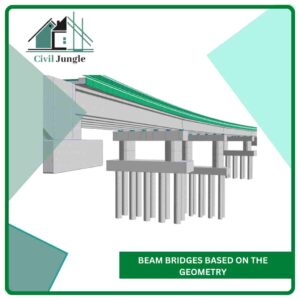
#a Straight Beam Bridge
Street beams at the horizontal component which are used to support vertical loads.
#b Curved Beam Bridge
In the curved beam, there are some assumptions which are taken like the cross-section has access of symmetry in a plane along with the length of the beam. The modulus of elasticity e remains the same in tension and compression.
#c Tapered Beam Bridge
The stress analysis of the tapered beam is different as compared to the uniform beam section. The tapered beam is subjected to the tip bending load which is analysed to predict the distributions of stresses.
#2 Classification of Beam Bridge Based on the Shape

#a I Beam Bridge
I-beam beams are more economical and easy to fabricate. I-Beam has a high moment of inertia which will help to resist the moment.
#b T Beam Bridge
This type of beam is made monolithically with the reinforced cement concrete.
#c C Beam Bridge
C-beam is also known as channel Beam. It has high load carrying capacity and can be made from concrete, steel and heavy wood.
#3 Classification Based on the Equilibrium Conditions

#a Statically Determinate Beam Bridge
In regards to beams, if the reaction forces can be calculated using equilibrium equations alone, they are statically determinate.
On the other hand, if the reaction force can’t be determined using equilibrium equations only, other methods have to be used, and the structure is said to be statically indeterminate.
#b Statically Indeterminate Beam Bridge
The structures of the bridges which cannot be analysed using statics equations only, they may require material properties.
#4 Classification Based on the Type of Support

#a Simply Supported Beam Bridge
supports, it is called a simply supported beam bridge. If two or more beams are joined rigidly together over supports, the bridge becomes continuous.
#b Cantilever Beam Bridge
Cantilever beam Bridge is a type of beam Bridge which is supported at one end only and free at another end.
#c Overhanging Beam Bridge
Overhanging beam has at least two supports at one end and other is at another end.
#d Continuous Beam Bridge
Continuous beam Bridge is a type of bridge which has more than two supports.
#e Fixed Beam Bridge
Fixed Beam Bridge is a type of bridge which is rigidly fixed at both ends.
How Does a Beam Bridge Works?
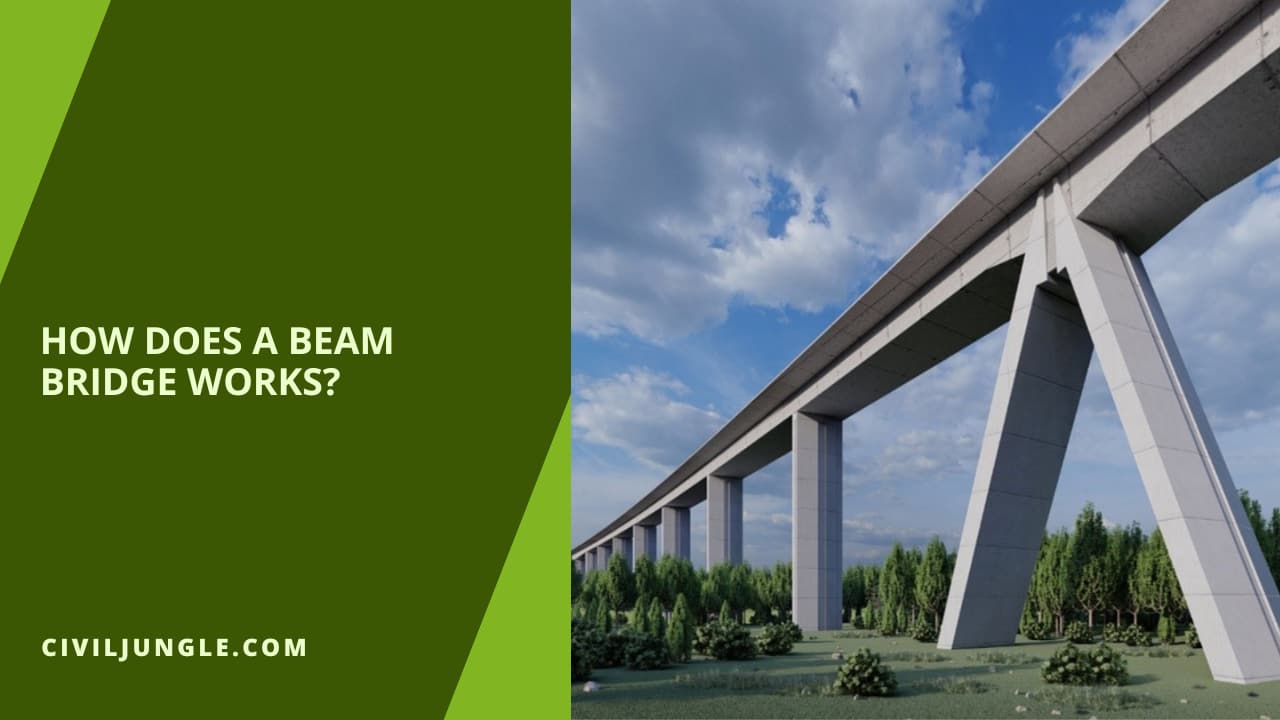
The Beam bridge is simply a horizontal slab which rests on the supports at the ends. The support carries the load coming on the bridge due to heavy traffic and transfers it to the foundation.
In case of the beam Bridge, the whole weight of the beam pushes straight down on the piers or the supports. The beam should be strong such that it does not bend under its self-weight it and the additional weight by the movement of heavy traffic.
When the load coming from the heavy traffic tends the Beam to bend. In this case, the upper edge of the beam is in compression and the bottom portion of the beam is in tension.
Beam bridge can endure both compressive stresses as well as tensile stresses. Beam bridges weight and strength depend upon the distance off the bridge. The strength of the beam Bridge is influenced by the distance between two piers.
The bridge mainly consists of three elements which are:
- Substructure
- Superstructure
- Deck of the Bridge

#1. Substructure
The substructure consists of the foundation which transfers the load of the weight of the bridge to the underground Strata. It also consists of columns or piers and abutments
#2. Superstructure
The superstructure of the bridge is the horizontal slab which spans between the two supports.
#3. Deck of the Bridge
The function of the Deck of the bridge is to carry the movement of traffic from one end to another end.
Advantages of Beam Bridges
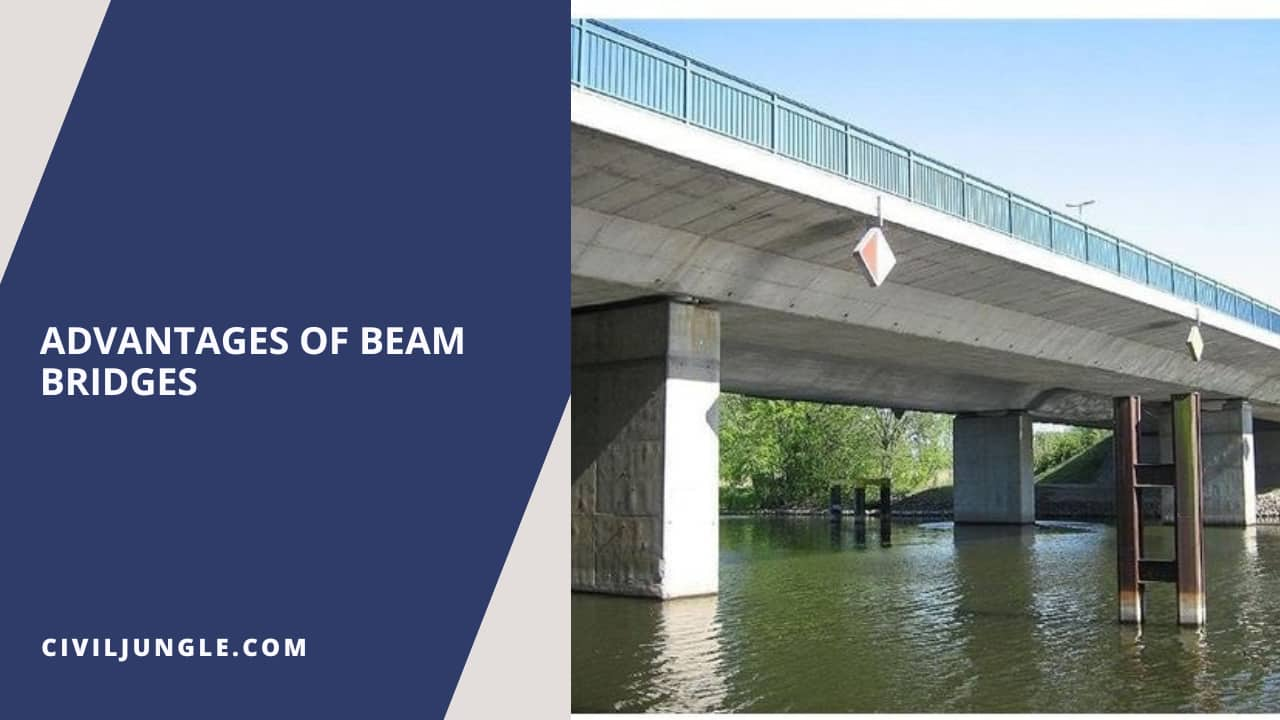
There are many advantages of a beam and column bridge as well as general beam bridge advantages which are as follows
- Beam bridges are very simple and easy to construct.
- Beam bridges are mostly used in the rural and urban areas.
- In the construction of beam bridges, the Beam rests simply on the supports.
- Beam bridges are economical as compared to other types of bridges.
- Beam bridges can easily sustain the effects of thermal expansion and movements of the ground.
Disadvantages of Beam Bridges

- The disadvantages of a beam and column bridge as well as general beam bridge disadvantages include the fact that the construction of Beam Bridge is expensive for longer spans.
- Beam bridges undergo a significant amount of wear and tear.
- Beam Bridges required more Maintenance as compared to the other types of bridges.
- The Beam Bridge is only suitable for the short distance.
- Beam bridges are not aesthetical good as compared to other bridges.
- Beam bridges may start to sag due to excessive loads.
Beam Bridges Examples
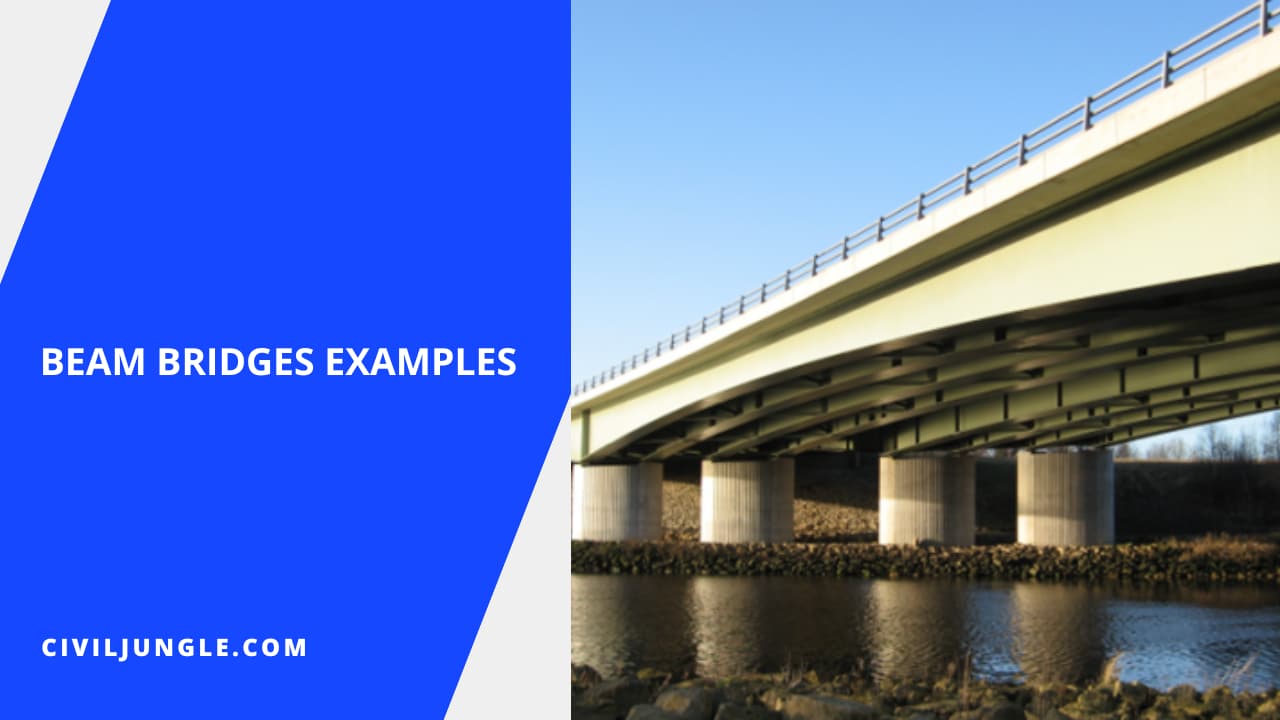
Some Famous beam Bridge are listed below:
- Vikram Shila Bridge
- Lake Pontchartrain Causeway, Louisiana
- Manchac Swamp Bridge
Vikram Shila Bridge

Lake Pontchartrain Causeway, Louisiana

Manchac Swamp Bridge

Frequently Asked Questions (FAQ) about Beam Bridges
What Is a Beam Bridge?
A beam bridge is one of the most common types of bridges, characterized by its simple structure consisting of a horizontal beam supported at each end by piers or abutments. It is often used for short to medium spans and can carry various types of traffic.
What Materials Are Commonly Used in the Construction of Beam Bridges?
Beam bridges can be constructed using several materials, including timber, iron, steel, reinforced cement concrete, and prestressed concrete. Prestressed concrete is particularly advantageous due to its ability to withstand high compressive stresses.
What Are the Different Types of Beam Bridges Based on Their Geometry?
Beam bridges based on geometry include:
- Straight Beam Bridge: Horizontal beams that support vertical loads.
- Curved Beam Bridge: Features a curved beam with symmetrical cross-sections along its length.
- Tapered Beam Bridge: Has a beam that gradually changes in cross-sectional area, affecting stress distribution.
How Are Beam Bridges Classified Based on Their Cross-Sectional Shape?
The main types based on cross-sectional shape are:
- I-Beam Bridge: Features an I-shaped cross-section, providing high resistance to bending.
- T-Beam Bridge: Made with reinforced cement concrete and shaped like a T.
- C-Beam Bridge: Also known as channel beam, it has a C-shaped cross-section and high load-carrying capacity.
What Is the Difference Between Statically Determinate and Statically Indeterminate Beam Bridges?
- Statically Determinate Beam Bridge: Can be analyzed using equilibrium equations alone to find reaction forces.
- Statically Indeterminate Beam Bridge: Requires additional methods or material properties for analysis beyond equilibrium equations.
What Types of Supports Are Used in Beam Bridges?
Beam bridges can be supported in various ways:
- Simply Supported: Supported at both ends with no additional constraints.
- Cantilever: Supported at one end only, with the other end extending freely.
- Overhanging: Has supports at one end and an overhanging portion at the other.
- Continuous: Supported by more than two supports along its length.
- Fixed: Rigidly fixed at both ends.
How Does a Beam Bridge Work?
A beam bridge works by transferring loads from the bridge deck to the supports at each end. The weight of the bridge and the load from traffic cause the beam to bend, with the upper portion experiencing compression and the lower portion experiencing tension.
What Are the Main Components of a Beam Bridge?
The main components are:
- Substructure: Includes the foundation, columns, piers, and abutments that transfer the load to the ground.
- Superstructure: The horizontal slab or beam that spans between supports.
- Deck: The surface of the bridge that carries the traffic.
What Are the Advantages of Beam Bridges?
- Simple and economical to construct.
- Suitable for both rural and urban areas.
- Can handle thermal expansion and ground movements effectively.
What Are the Disadvantages of Beam Bridges?
- Not ideal for long spans, as construction becomes expensive.
- Subject to significant wear and tear.
- Requires regular maintenance.
- Less aesthetically pleasing compared to other bridge types.
- May sag under excessive loads.
Can You Provide Examples of Famous Beam Bridges?
- Vikram Shila Bridge
- Lake Pontchartrain Causeway, Louisiana
- Manchac Swamp Bridge


it is very nice article about bridge and helpful for civil engineers and related peoples.
Superb article written with indepth research, I recommend all to read this article. Thanks for providing such valuable articles.